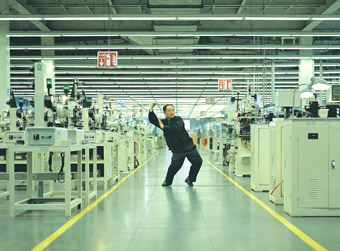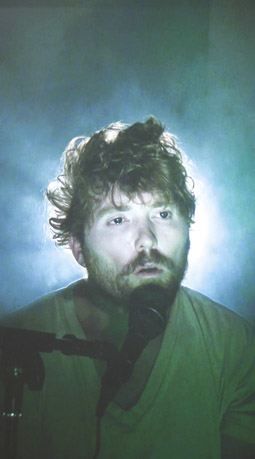mediated: craving for expression
jacqueline millner: anne landa award exhibitions, agnsw

My Future is Not a Dream 01-08, 2006, Cao Fei
courtesy the artist and Lombard-Freid Projects
My Future is Not a Dream 01-08, 2006, Cao Fei
2009 SAW SOME REVISIONS TO THE ANNE LANDA AWARD EXHIBITION, ESTABLISHED IN 2004 AND NOW IN ITS THIRD INCARNATION: IT WAS THEMATISED (AROUND THE IDEA OF DOUBLES AND SPLIT IDENTITIES), IT WAS NO LONGER CURATED IN-HOUSE (GUEST CURATOR VICTORIA LYNN), BUT MORE SIGNIFICANTLY, IT WAS NO LONGER LIMITED TO AUSTRALIAN ARTISTS.
This may ultimately prove a positive move, providing more opportunities to view high quality video and ‘new’ media from around the world, and in general raising the bar and the profile of the exhibition. This year, however, the new format resulted in the work of local artists being overshadowed by the reach, ambition and emotional punch of their international counterparts’ projects.
Take Whose Utopia? (2006), Cao Fei’s elegiac three-part video of factory life in China. The first part is an aesthetic paean to the processes of mass manufacture, with close-ups of seamless human/machine interaction that serves as a curious rebuttal to the industrial anomie and terminal mistiming comically captured in Chaplin’s Modern Times. But it is the second part that really captivates, as the workers of the first part emerge from anonymity as complex individuals enacting their fantasies amid the factory hardware. The workers dream of tutus and angel wings, electric guitars and graceful choreography, of deploying the fine motor skills required to sort light-bulb filaments instead to emulate the delicate gestures of a dying swan. The fantasies are not the stereotypical Western blue-collar dreams of wealth and status, love and sex. Rather the workers crave creative expression; their idealised figure is none other than ‘the artist’, specifically the performing artist.
The figure of the performing artist is also the focus of fantasy for the young Indonesian Smiths fans who answered Phil Collins’ call to participate in the third chapter of his globe-trotting The World Won’t Listen (2004-7), a video that documents karaoke versions of the British band’s classic album of 1986. I was initially skeptical of Collins’ project. The artist claims his gambit would not have worked if staged in “the first world circuits of pop and cultural industries” because he aimed to explore the reception of pop in places where it may have seemed as much “an imposition as a gift” (Collins cited in Catherine Fowler’s essay in Anne Landa catalogue, AGNSW, 2009). Yet I suspect the chosen settings of Guatemala, Turkey and Indonesia had more to do with the enduring allure of the exotic to the Western eye, and the promise of the simultaneously poignant and absurd slippages that can occur when a first world cultural form is appropriated by the geo-politically marginalized. And yet, the video manages to transcend its problematic politics through the utter conviction of the performers, some of whom emerge from their reverie as if from spiritual possession, physically trembling. Rather than evoking cultural ventriloquism, these devastatingly beautiful anthems of class and teenage alienation appear to belong to these singers. As they sing “Hang the blessed DJ, because the music that they constantly play, has nothing to say about my life” (from the song Panic), the cross-cultural implications may be complex, but the lyrics ring with Morrissey’s original meaning.

Nina, Me and Ricky Jay 2009, TV Moore, VHS & DVD transferred to DVD
courtesy the artist
Nina, Me and Ricky Jay 2009, TV Moore, VHS & DVD transferred to DVD
Music’s transformative power also subtends TV Moore’s award winning entry, a loose amalgam of sculptural installations—including a mirror ball, a TV/stereo cabinet and cymbals suspended from the ceiling—and videos on various screens that include the artist singing under hypnosis. This unedited evocation of the artist’s artificially induced altered states, with its at times ham-fisted symbolism and overloaded imagery, lacks the resonance and conceptual refinement of Moore’s earlier videos. While maximalism may have cost Moore, at the other end of the spectrum, the intuitive communication between twins is not enough to redeem the Mangano sisters’ video, Absence of Innocence (2008) from a certain lack of content.
Mari Velonaki’s Circle D: Fragile Balances, 2008, Circle E: Fragile Balance 2009, an attempt to challenge our expectations of what makes for a robot and a computer interface, through the design of blue-tooth enabled hand-held boxes that ‘write’ messages to each other, was compelling, but still in need of some development. In particular it would be fascinating to see a real time connection between messages scrawled by visitors and the screens on the boxes.
Finally, Lisa Reihana’s Digital Marae (2001 and 2007) offered a witty updating of the Maori ancestral meeting house. The artist replaced traditional elders with life-sized digital prints of ordinary Maori men, in the guise of figures from Maori legend, and traditional hand-crafted motifs with computer-generated animated patterns (Tukutuku: Terrain, 2009). The work has great aesthetic power, although its installation along the exhibition space’s external wall detracted from its intensity.
While Double Take may not shed much additional light on the experience of multiple personalities and split identities, through the works of Collins, Reihana and Cao Fei, in particular, it speaks poignantly about the intrinsic human need for creative expression. These works derive their power in large part from the artists deploying their own artistic agency to nurture that of the ostensibly dispossessed.
Double Take: Anne Landa Award for Video and New Media Art, artists Phil Collins, Cao Fei, Gabriella Mangano, Silvana Mangano, TV Moore, Lisa Reihana, Mari Velonaki, guest curator Victoria Lynn, Art Gallery of New South Wales, May 7-July 19
RealTime issue #91 June-July 2009 pg. 32






